Analysis of Long-Term Variations of Drought Characteristics Using Standardized Precipitation Index over Zambia
Abstract
1. Introduction
2. Study Area, Data, and Methods
2.1. Study Area
2.2. Data
2.3. Methodology
2.3.1. Spatial–Temporal Trend Analysis
2.3.2. Sens Slope
2.3.3. Mann–Kendall Test
2.3.4. Standardized Precipitation Index (SPI)
2.3.5. Drought Characteristics
2.3.6. ENSO Influence on Drought
3. Results and Discussion
3.1. Rainfall Characteristics
3.1.1. Spatial Distribution of Monthly Rainfall
3.1.2. Annual Rainfall Cycle and Interannual Rainfall Variability
3.2. Spatial Patterns of Drought
3.2.1. Spatial Distribution of Drought Duration, Severity, and Intensity
3.2.2. Spatial Distribution of Drought Trends
3.3. Temporal Patterns of Droughts
3.3.1. Long-Term Monthly Time Series Drought Variation
3.3.2. Annual and Seasonal Drought Trends
3.4. The Relationship between ENSO and Drought
4. Conclusions
Author Contributions
Funding
Acknowledgments
Conflicts of Interest
References
- Parsons, D.J.; Rey, D.; Tanguy, M.; Holman, I.P. Regional variations in the link between drought indices and reported agricultural impacts of drought. Agric. Syst. 2019, 173, 119–129. [Google Scholar] [CrossRef]
- Buckland, R.; Eele, G.; Mugwara, R. Food aid and human security. In Humanitarian Crisis and Natural Disasters: A SADC Perspective; Stokker, O.S., Ed.; European Association of Development Research, Fank Cass Publishers: London, UK, 2000; pp. 181–195. [Google Scholar]
- IPCC. Changes in Climate Extremes and Their Impacts on the Natural Physical Environment. In Managing the Risks of Extreme Events and Disasters to Advance Climate Change Adaptation: Special Report of the Intergovernmental Panel on Climate Change; Field, C.B., Barros, V., Stocker, T.F., Qin, D., Dokken, D.J., Ebi, K.L., Mastrandrea, M.D., Mach, K.J., Plattner, G.-K., Allen, S.K., et al., Eds.; Cambridge University Press: Cambridge, UK, 2012. [Google Scholar]
- Taylor, K.E.; Stouffer, R.J.; Meehl, G.A. An overview of CMIP5 and the experiment design. Bull. Am. Meteorol. Soc. 2012, 93, 485–498. [Google Scholar]
- Zhao, T.; Dai, A. The Magnitude and Causes of Global Drought Changes in the Twenty-First Century under a Low–Moderate Emissions Scenario. J. Clim. 2015, 28, 4490–4512. [Google Scholar] [CrossRef]
- Dai, A. Drought under global warming: a review. Wiley Interdiscip. Rev. Clim. Chang. 2011, 2, 45–65. [Google Scholar] [CrossRef]
- Burke, E.J. Understanding the Sensitivity of Different Drought Metrics to the Drivers of Drought under Increased Atmospheric CO2. J. Hydrometeorol. 2011, 12, 1378–1394. [Google Scholar] [CrossRef]
- Scheff, J.; Frierson, D.M.W. Robust future precipitation declines in CMIP5 largely reflect the poleward expansion of model subtropical dry zones. Geophys. Res. Lett. 2012, 39. [Google Scholar] [CrossRef]
- Trenberth, K.E.; Fasullo, J.T. Global warming due to increasing absorbed solar radiation. Geophys. Res. Lett. 2009, 36. [Google Scholar] [CrossRef]
- Loomis, R.S. Feeding a World Population of More than Eight Billion People: A Challenge to Science. Crop. Sci. 1999, 39, 1250. [Google Scholar] [CrossRef]
- Al-Kaisi, M.M.; Elmore, R.W.; Guzman, J.G.; Hanna, H.M.; Hart, C.E.; Helmers, M.J.; Hodgson, E.W.; Lenssen, A.W.; Mallarino, A.P.; Robertson, A.E.; et al. Drought impact on crop production and the soil environment: 2012 experiences from Iowa. J. Soil Water Conserv. 2013, 68, 19A–24A. [Google Scholar] [CrossRef]
- Doughty, C.E.; Metcalfe, D.B.; Girardin, C.A.J.; Amézquita, F.F.; Cabrera, D.G.; Huasco, W.H.; Silva-Espejo, J.E.; Araujo-Murakami, A.; Da Costa, M.C.; Rocha, W.; et al. Drought impact on forest carbon dynamics and fluxes in Amazonia. Nat. Cell Biol. 2015, 519, 78–82. [Google Scholar] [CrossRef]
- Hill, M. World’s Biggest Dam Has ‘Extremely Dangerous’ Low Water Levels. 2017. Available online: https://www.bloomberg.com/news/articles/2016-01-08/world-s-biggest-dam-has-extremely-dangerous-low-water-levels (accessed on 10 September 2020).
- Muchuru, S.; Landman, W.; DeWitt, D.; Lötter, D. Seasonal rainfall predictability over the Lake Kariba catchment area. Water SA 2014, 40, 461. [Google Scholar] [CrossRef]
- Tsubo, M.; Walker, S. An assessment of productivity of maize grown under water harvesting system in a semi-arid region with special reference to ENSO. J. Arid Environ. 2007, 71, 299–311. [Google Scholar] [CrossRef]
- Rouault, M.; Richard, Y. Intensity and spatial extension of drought in South Africa at different time scales. Water SA 2004, 29, 489–500. [Google Scholar] [CrossRef]
- Winkler, K.; Gessner, U.; Hochschild, V. Identifying Droughts Affecting Agriculture in Africa Based on Remote Sensing Time Series between 2000–2016: Rainfall Anomalies and Vegetation Condition in the Context of ENSO. Remote Sens. 2017, 9, 831. [Google Scholar] [CrossRef]
- Richard, Y.; Fauchereau, N.; Poccard, I.; Rouault, M.; Trzaska, S. 20th century droughts in southern Africa: spatial and temporal variability, teleconnections with oceanic and atmospheric conditions. Int. J. Clim. 2001, 21, 873–885. [Google Scholar] [CrossRef]
- Reason, C.J.C.; Jagadheesha, D. A model investigation of recent ENSO impacts over southern Africa. Theor. Appl. Clim. 2005, 89, 181–205. [Google Scholar] [CrossRef]
- Findell, K.L.; Delworth, T.L. Impact of Common Sea Surface Temperature Anomalies on Global Drought and Pluvial Frequency. J. Clim. 2010, 23, 485–503. [Google Scholar] [CrossRef]
- Giannini, A.; Biasutti, M.; Held, I.M.; Sobel, A.H. A global perspective on African climate. Clim. Chang. 2008, 90, 359–383. [Google Scholar] [CrossRef]
- Nicholson, S.E. AN ANALYSIS OF THE ENSO SIGNAL IN THE TROPICAL ATLANTIC AND WESTERN INDIAN OCEANS. Int. J. Clim. 1997, 17, 345–375. [Google Scholar] [CrossRef]
- Behera, S.K.; Yamagat, H.W.A.T. Subtropical SST dipole events in the southern Indian Ocean. Geophys. Res. Lett. 2001, 28, 327–330. [Google Scholar] [CrossRef]
- Reason, C.J.C. Sensitivity of the southern African circulation to dipole sea-surface temperature patterns in the south Indian Ocean. Int. J. Clim. 2002, 22, 377–393. [Google Scholar] [CrossRef]
- Wilhite, D.A. Drought as a natural hazard: concepts and definitions. In Drought: A Global Assessment; Routledge: London, UK, 2000; pp. 3–18. [Google Scholar]
- Łabędzki, L. Estimation of local drought frequency in central Poland using the standardized precipitation index SPI. Irrig. Drain. 2007, 56, 67–77. [Google Scholar] [CrossRef]
- Mishra, A.K.; Singh, V.P. A review of drought concepts. J. Hydrol. 2010, 391, 202–216. [Google Scholar] [CrossRef]
- Manatsa, D.; Mukwada, G.; Siziba, E.; Chinyanganya, T. Analysis of multidimensional aspects of agricultural droughts in Zimbabwe using the Standardized Precipitation Index (SPI). Theor. Appl. Clim. 2010, 102, 287–305. [Google Scholar] [CrossRef]
- Almedeij, J. Drought Analysis for Kuwait Using Standardized Precipitation Index. Sci. World J. 2014, 2014, 451841. [Google Scholar] [CrossRef]
- Guttman, N.B. ACCEPTING THE STANDARDIZED PRECIPITATION INDEX: A CALCULATION ALGORITHM1. JAWRA J. Am. Water Resour. Assoc. 1999, 35, 311–322. [Google Scholar] [CrossRef]
- Du, J.; Fang, J.; Xu, W.; Shi, P. Analysis of dry/wet conditions using the standardized precipitation index and its potential usefulness for drought/flood monitoring in Hunan Province, China. Stoch. Environ. Res. Risk Assess. 2013, 27, 377–387. [Google Scholar] [CrossRef]
- Kaluba, P.; Verbist, K.M.J.; Cornelis, W.M.; Van Ranst, E. Spatial mapping of drought in Zambia using regional frequency analysis. Hydrol. Sci. J. 2017, 62, 1825–1839. [Google Scholar] [CrossRef]
- Libanda, B.; Zheng, M.; Ngonga, C. Spatial and temporal patterns of drought in Zambia. J. Arid. Land 2019, 11, 180–191. [Google Scholar] [CrossRef]
- Efstathiou, M.N.; Varotsos, C.A. Intrinsic properties of Sahel precipitation anomalies and rainfall. Theor. Appl. Clim. 2012, 109, 627–633. [Google Scholar] [CrossRef]
- Geiger, R. Klassifikation der Klimate nach W. Köppen. In Landolt-Börnstein—Zahlenwerte und Funktionen aus Physik, Chemie, Astronomie, Geophysik und Technik; alte Serie; Springer: Berlin, Germany, 1954; Volume 3, pp. 603–607. [Google Scholar]
- Hachigonta, S.; Reason, C. Interannual variability in dry and wet spell characteristics over Zambia. Clim. Res. 2006, 32, 49–62. [Google Scholar] [CrossRef]
- Brigadier, L.; Ogwang, B.A.; Victor, O.; Ngonga, C.; Nyasa, L. Diagnosis of the 2010 DJF flood over Zambia. Nat. Hazards 2015, 81, 189–201. [Google Scholar] [CrossRef]
- Mwafulirwa, N.D. Climate Variability and Predictability in Tropical Southern Africa with a Focus on Dry Spells over Malawi. Master’s Thesis, Faculty of Science, University of Zululand, Zululand, Sauth Africa, 1999. [Google Scholar]
- Brigadier, L.; Barbara, N.; Bathsheba, M. Rainfall Variability over Northern Zambia. J. Sci. Res. Rep. 2015, 6, 416–425. [Google Scholar] [CrossRef]
- Cook, C.; Reason, C.; Hewitson, B.C. Wet and dry spells within particularly wet and dry summers in the South African summer rainfall region. Clim. Res. 2004, 26, 17–31. [Google Scholar] [CrossRef]
- Sen, P.K. Estimates of the regression coefficient based on Kendall’s tau. J. Am. Stat. Assoc. 1968, 63, 1379–1389. [Google Scholar] [CrossRef]
- Theil, H. A rank-invariant method of linear and polynomial regression analysis, 3; confidence regions for the parameters of polynomial regression equations. Indag. Math. 1950, 1, 467–482. [Google Scholar]
- Mumo, L.; Yu, J.; Fang, K. Assessing Impacts of Seasonal Climate Variability on Maize Yield in Kenya. Int. J. Plant Prod. 2018, 12, 297–307. [Google Scholar] [CrossRef]
- Ongoma, V.; Chen, H. Temporal and spatial variability of temperature and precipitation over East Africa from 1951 to 2010. Theor. Appl. Clim. 2017, 129, 131–144. [Google Scholar] [CrossRef]
- Mann, H.B. Non-parametric tests against trend. Econometrica 1945, 13, 245–259. [Google Scholar] [CrossRef]
- Sneyers, R. On the Statistical Analysis of Series of Observations; World Meteorological Organization (WMO): Geneva, Switzerland, 1990. [Google Scholar]
- Kendall, M. Rank Correlation Methods, 5th ed.; Oxford University Press: London, UK, 1975; p. 272. [Google Scholar]
- Prabhakar, A.; Singh, K.; Lohani, A. Regional level long-term rainfall variability assessment using Mann-Kendall test over the Odisha state of India. J. Agrometeorol. 2018, 20, 164–165. [Google Scholar]
- McKee, T.B.; Doesken, N.J.; Kleist, J. The relationship of drought frequency and duration to time scales. In Proceedings of the 8th Conference on Applied Climatology, Anaheim, CA, USA, 17–22 January 1993. [Google Scholar]
- Hayes, M.J.; Svoboda, M.D.; Wilhite, D.A.; Vanyarkho, O.V. Monitoring the 1996 Drought Using the Standardized Precipitation Index. Bull. Am. Meteorol. Soc. 1999, 80, 429–438. [Google Scholar] [CrossRef]
- Seiler, R.A.; Hayes, M.; Bressan, L. Using the standardized precipitation index for flood risk monitoring. Int. J. Clim. 2002, 22, 1365–1376. [Google Scholar] [CrossRef]
- Dogan, S.; Berktay, A.; Singh, V.P. Comparison of multi-monthly rainfall-based drought severity indices, with application to semi-arid Konya closed basin, Turkey. J. Hydrol. 2012, 470, 255–268. [Google Scholar] [CrossRef]
- Salehnia, N.; Alizadeh, A.; Sanaeinejad, H.; Bannayan, M.; Zarrin, A.; Hoogenboom, G. Estimation of meteorological drought indices based on AgMERRA precipitation data and station-observed precipitation data. J. Arid. Land 2017, 9, 797–809. [Google Scholar] [CrossRef]
- Thom, H.C.S. A NOTE ON THE GAMMA DISTRIBUTION. Mon. Weather. Rev. 1958, 86, 117–122. [Google Scholar] [CrossRef]
- Abramowitz, M.; Stegun, I.A. Handbook of Mathematical Functions with Formulas, Graphs, and Mathematical Tables; US Government Printing Office: Washington, DC, USA, 1970; Volume 55. [Google Scholar]
- Zhang, Q.; Zhang, J. Drought hazard assessment in typical corn cultivated areas of China at present and potential climate change. Nat. Hazards 2016, 81, 1323–1331. [Google Scholar] [CrossRef]
- Yevjevich, V.M. An objective Approach to Definitions and Investigations of Continental Hydrologic Droughts; no. 23; Colorado State University: Fort Collins, CO, USA, 1967; p. 18. [Google Scholar]
- Schwalm, C.R.; Anderegg, W.R.L.; Michalak, A.M.; Fisher, J.B.; Biondi, F.; Koch, G.; Litvak, M.; Ogle, K.; Shaw, J.D.; Wolf, A.; et al. Global patterns of drought recovery. Nat. Cell Biol. 2017, 548, 202–205. [Google Scholar] [CrossRef]
- Spinoni, J.; Naumann, G.; Carrao, H.; Barbosa, P.; Vogt, J. World drought frequency, duration, and severity for 1951–2010. Int. J. Climatol. 2014, 34, 2792–2804. [Google Scholar] [CrossRef]
- Mao, Y.; Wu, Z.; He, H.; Lu, G.; Xu, H.; Lin, Q. Spatio-temporal analysis of drought in a typical plain region based on the soil moisture anomaly percentage index. Sci. Total. Environ. 2017, 576, 752–765. [Google Scholar] [CrossRef]
- Xu, L.; Chen, N.; Zhang, X. Global drought trends under 1.5 and 2 °C warming. Int. J. Clim. 2018, 39, 2375–2385. [Google Scholar] [CrossRef]
- Gidey, E.; Dikinya, O.; Sebego, R.; Segosebe, E.; Zenebe, A. Modeling the Spatio-Temporal Meteorological Drought Characteristics Using the Standardized Precipitation Index (SPI) in Raya and Its Environs, Northern Ethiopia. Earth Syst. Environ. 2018, 2, 281–292. [Google Scholar] [CrossRef]
- Shah, R.; Bharadiya, N.; Manekar, V. Drought Index Computation Using Standardized Precipitation Index (SPI) Method For Surat District, Gujarat. Aquat. Procedia 2015, 4, 1243–1249. [Google Scholar] [CrossRef]
- Byakatonda, J.; Parida, B.P.; Moalafhi, D.B.; Kenabatho, P.K.; Lesolle, D. Investigating relationship between drought severity in Botswana and ENSO. Nat. Hazards 2019, 100, 255–278. [Google Scholar] [CrossRef]
- Libanda, B.; Zheng, M.; Banda, N. Variability of extreme wet events over Malawi. Geogr. Pannonica 2017, 21, 212–223. [Google Scholar] [CrossRef]
- Lweendo, M.K.; Lu, B.; Wang, M.; Zhang, H.; Xu, W. Characterization of Droughts in Humid Subtropical Region, Upper Kafue River Basin (Southern Africa). Water 2017, 9, 242. [Google Scholar] [CrossRef]
- Mpelasoka, F.; Awange, J.L.; Zerihun, A. Influence of coupled ocean-atmosphere phenomena on the Greater Horn of Africa droughts and their implications. Sci. Total. Environ. 2018, 610, 691–702. [Google Scholar] [CrossRef]
- Haile, G.G.; Tang, Q.; Leng, G.; Jia, G.; Wang, J.; Cai, D.; Sun, S.; Baniya, B.; Zhang, Q. Long-term spatiotemporal variation of drought patterns over the Greater Horn of Africa. Sci. Total. Environ. 2020, 704, 135299. [Google Scholar] [CrossRef]
- Choi, Y.-W.; Ahn, J.-B.; Suh, M.-S.; Cha, D.; Lee, D.-K.; Hong, S.-Y.; Min, S.-K.; Park, S.-C.; Kang, H.-S. Future changes in drought characteristics over South Korea using multi regional climate models with the standardized precipitation index. Asia-Pac. J. Atmos. Sci. 2016, 52, 209–222. [Google Scholar] [CrossRef]
- Steinemann, A.; Iacobellis, S.F.; Cayan, D.R. Developing and Evaluating Drought Indicators for Decision-Making. J. Hydrometeorol. 2015, 16, 1793–1803. [Google Scholar] [CrossRef]
- Usman, M.; Reason, C. Dry spell frequencies and their variability over southern Africa. Clim. Res. 2004, 26, 199–211. [Google Scholar] [CrossRef]
- Tiffen, M.; Mulele, M.R. The Environmental Impact of the 1991-92 Drought on Zambia; IUCN: Gland, Switzerland; Lusaka, Zambia, 1994; p. 108. [Google Scholar]
- Rasmusson, E.M.; Wang, X.; Ropelewski, C.F. The biennial component of ENSO variability. J. Mar. Syst. 1990, 1, 71–96. [Google Scholar] [CrossRef]

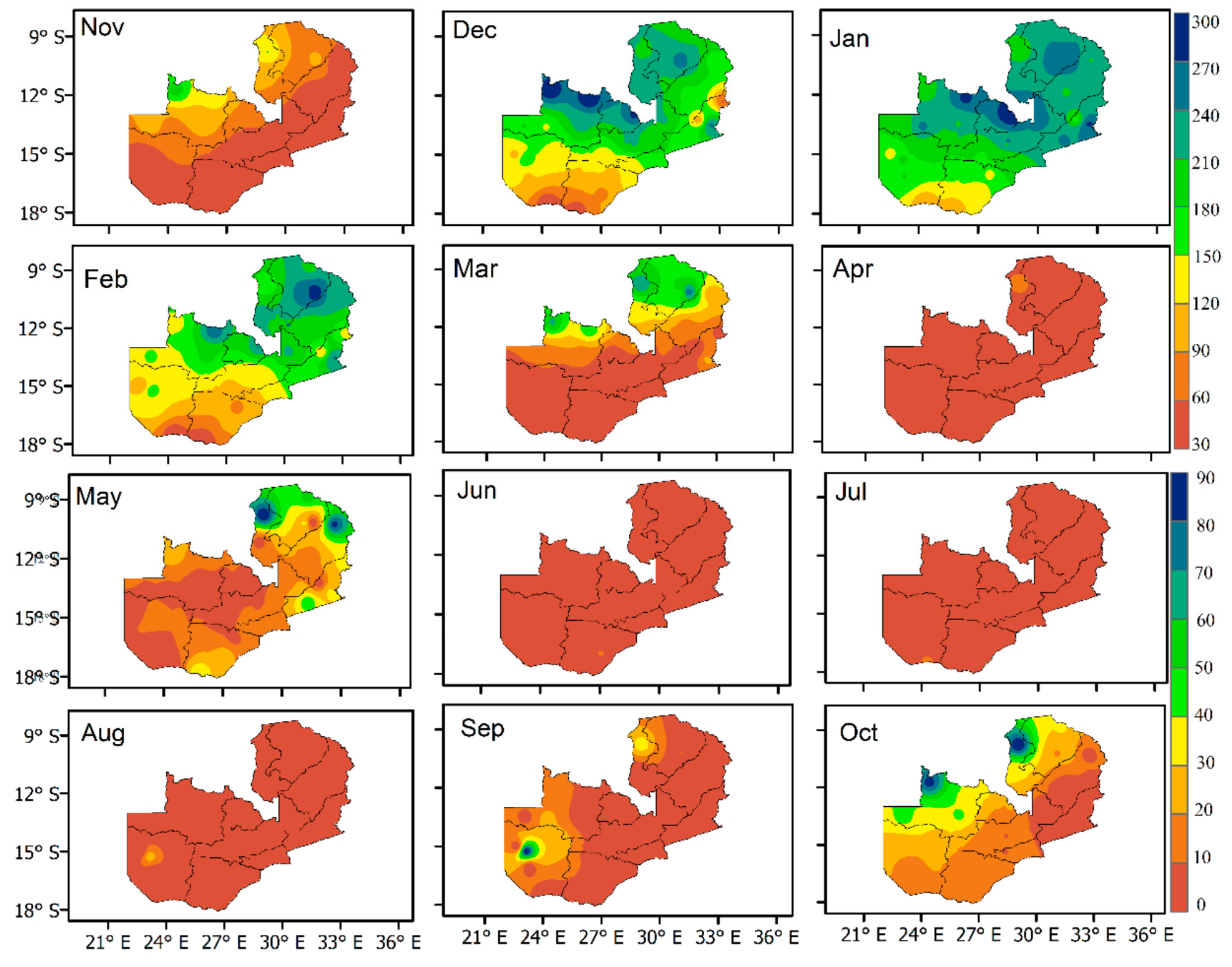
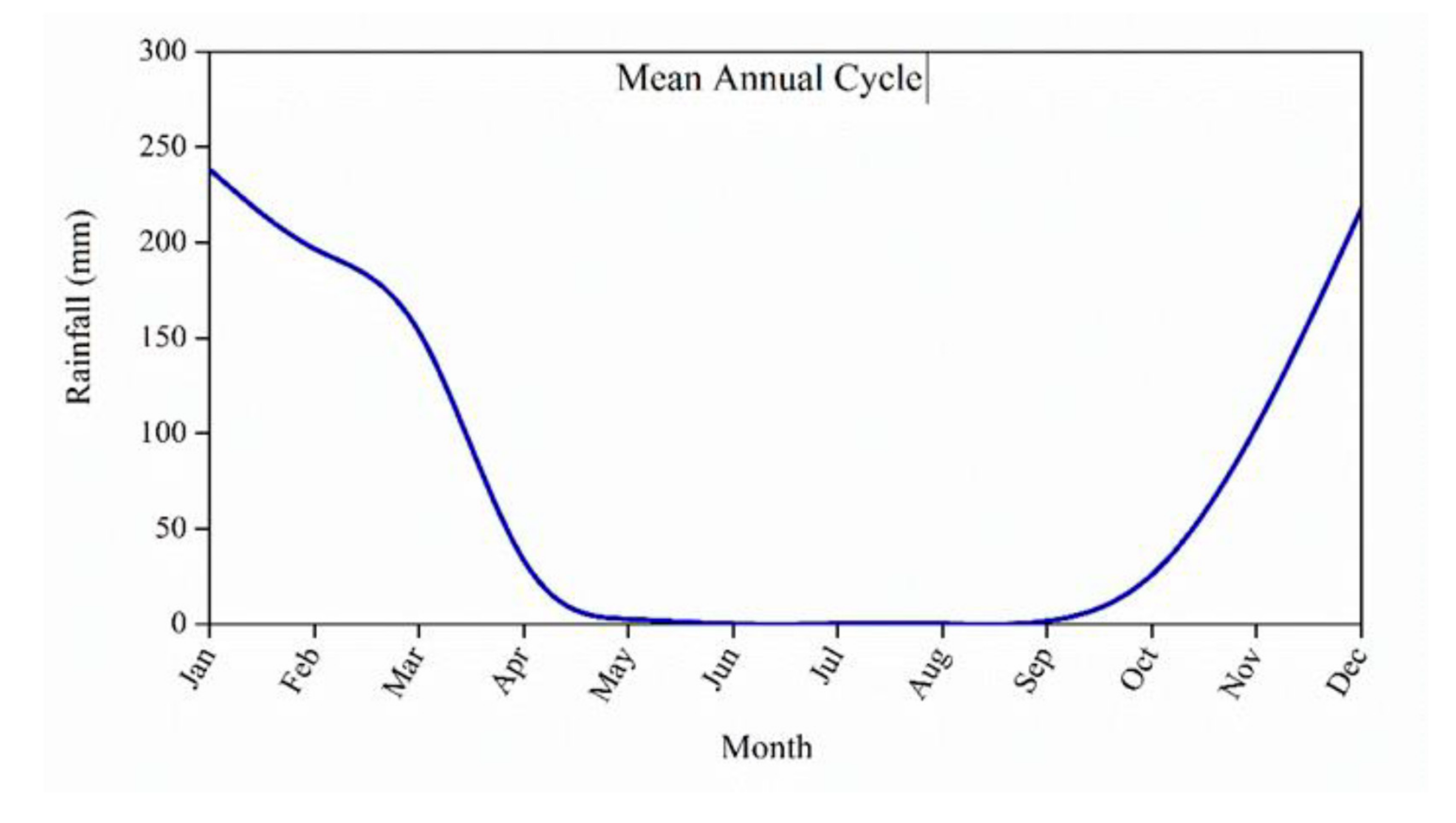
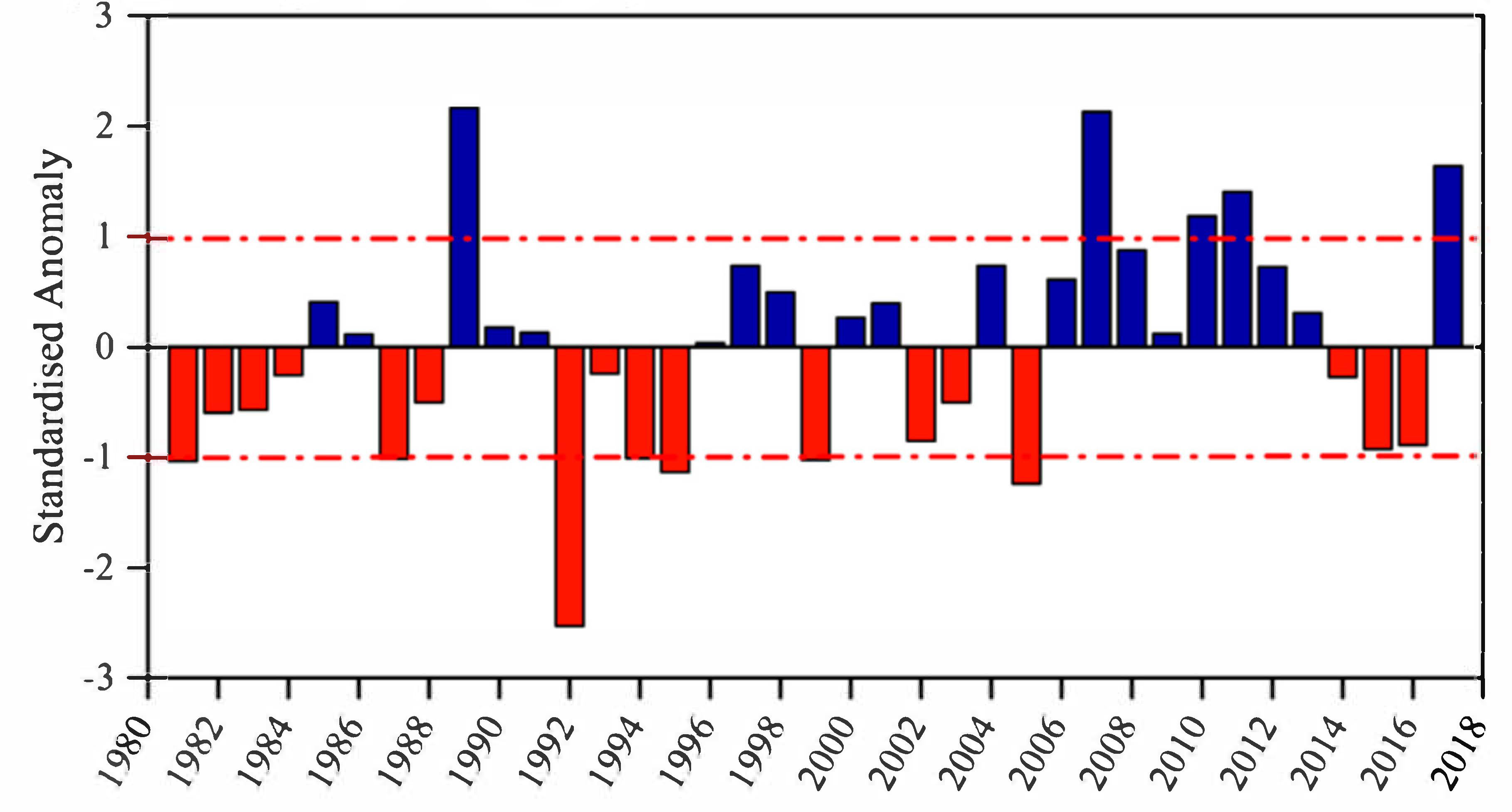
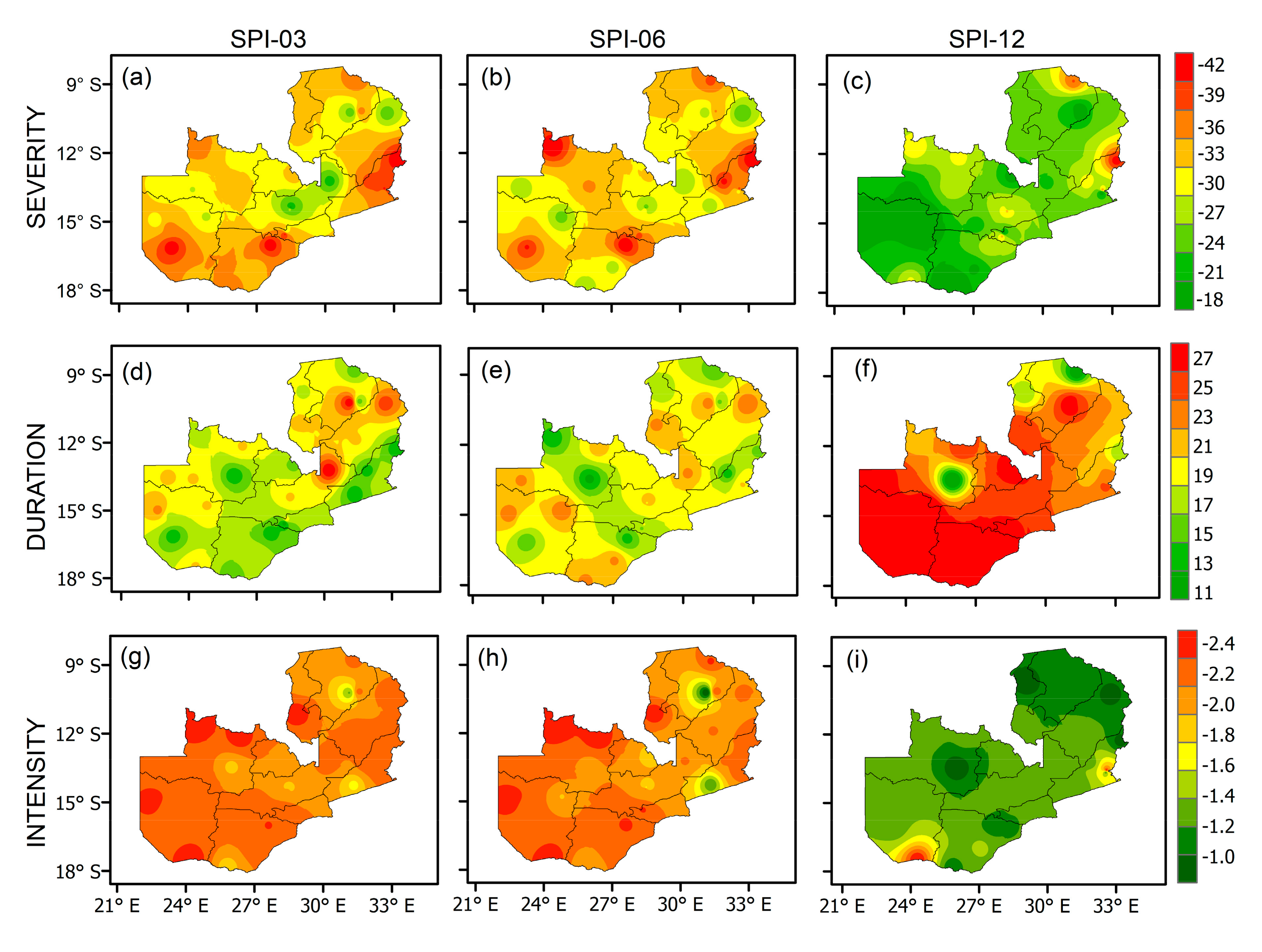

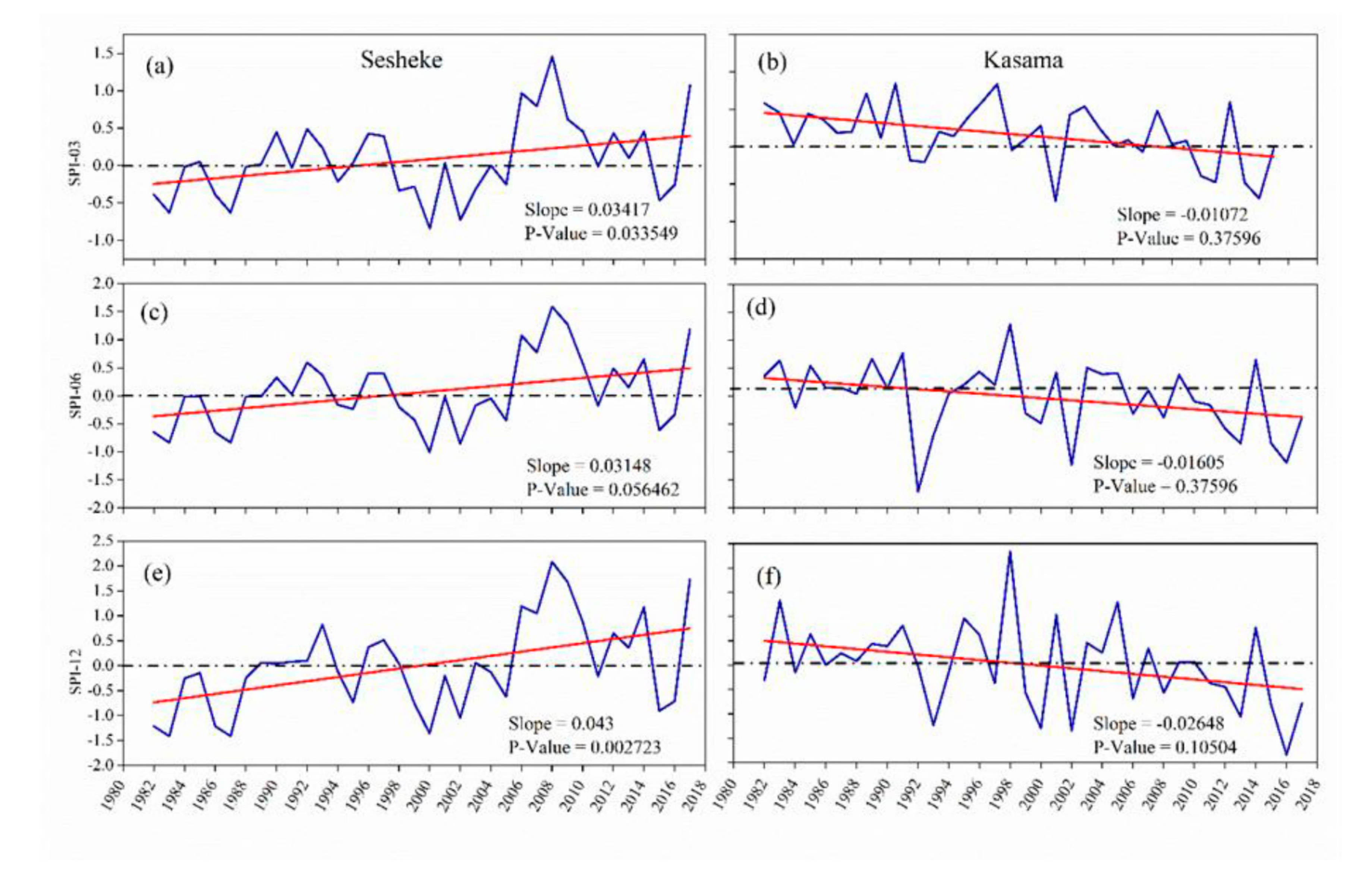
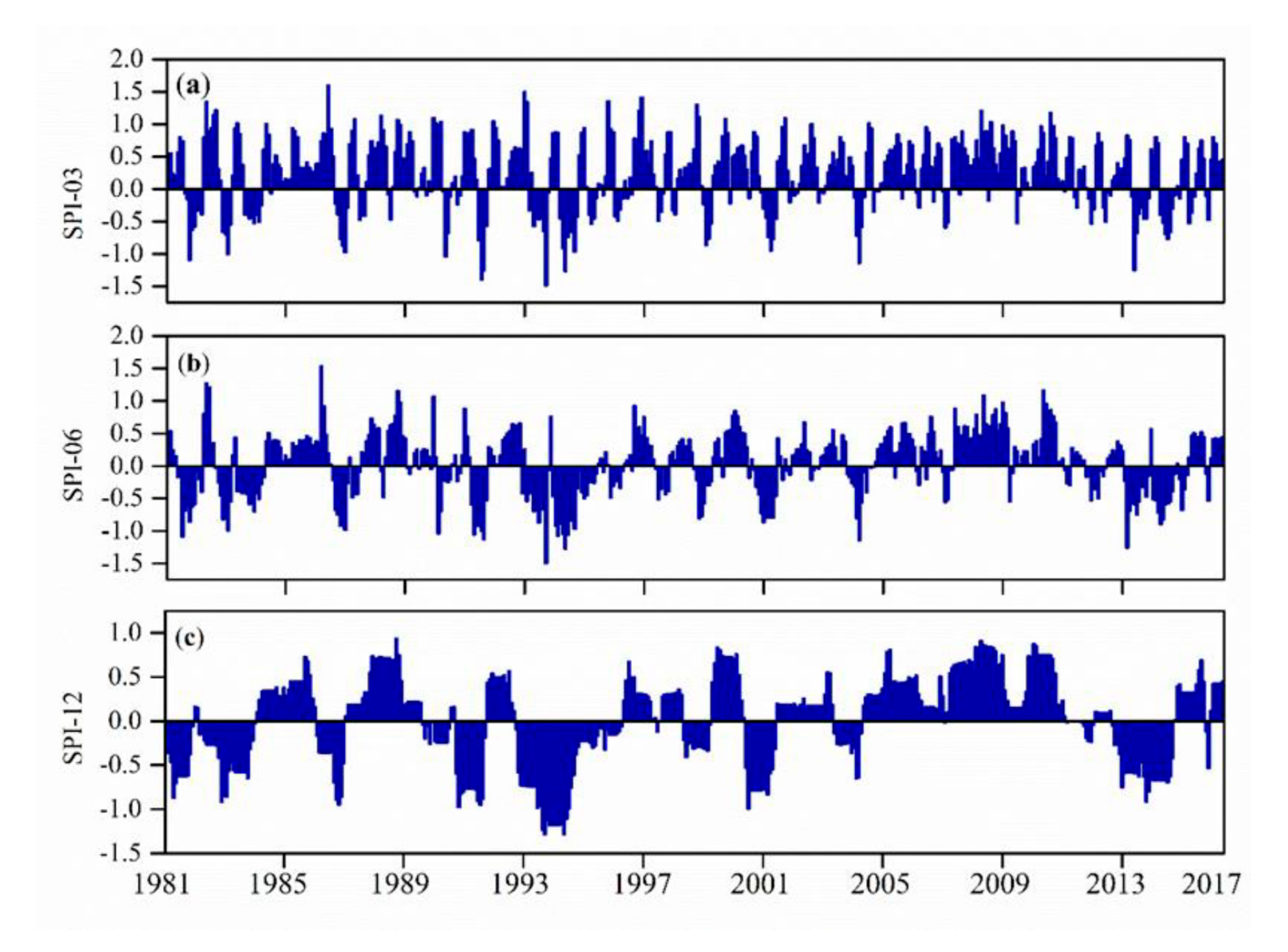
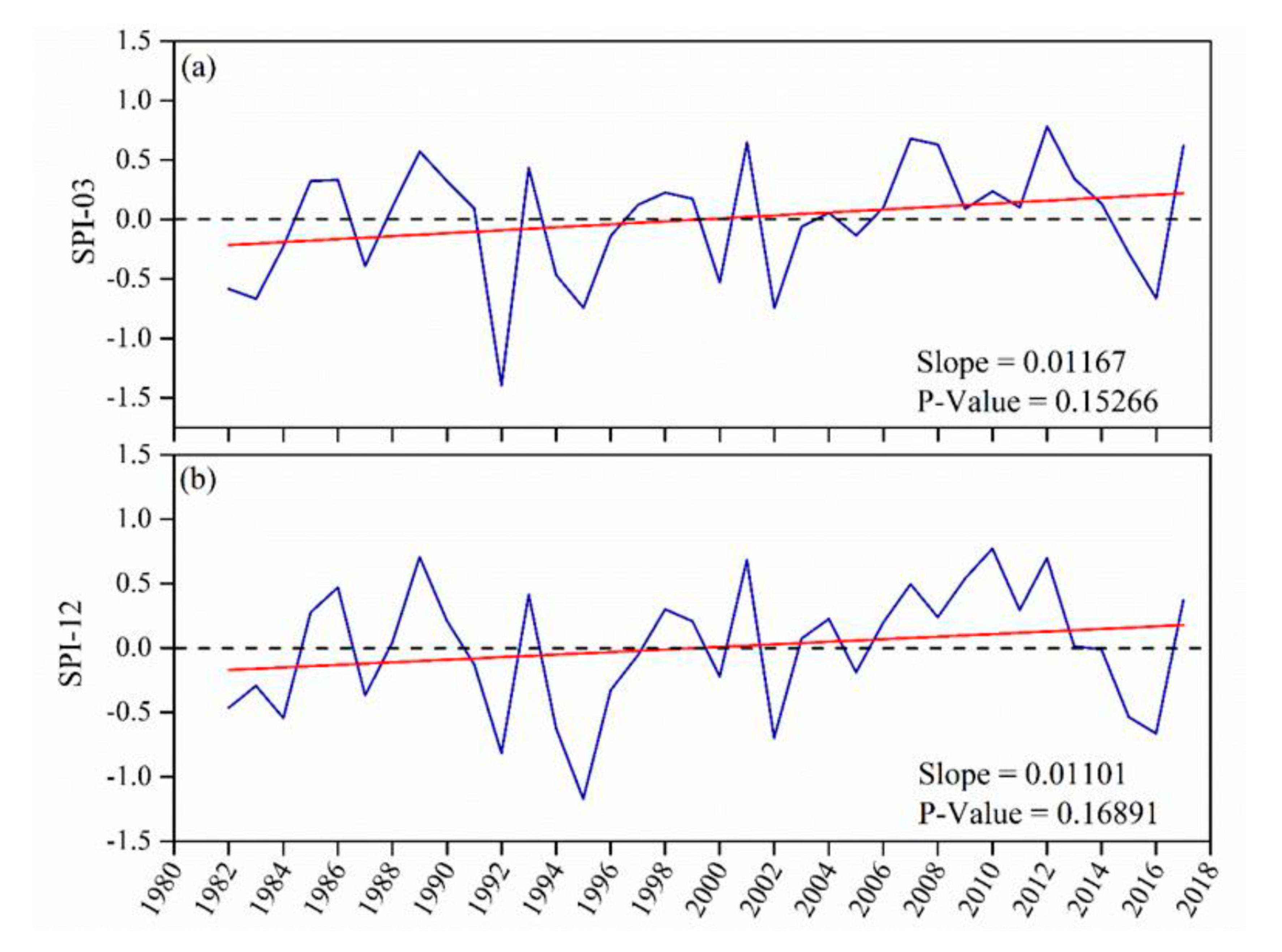
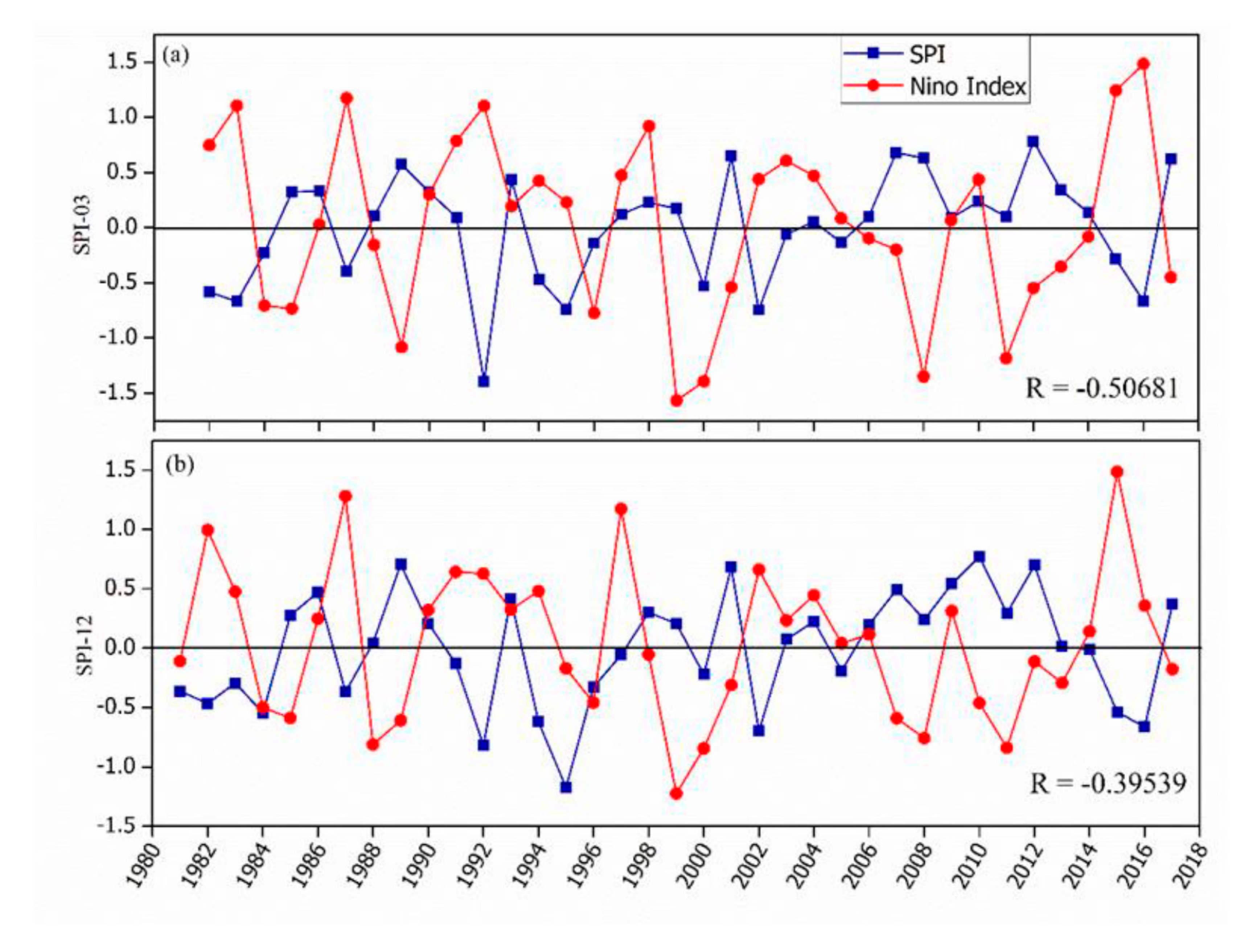
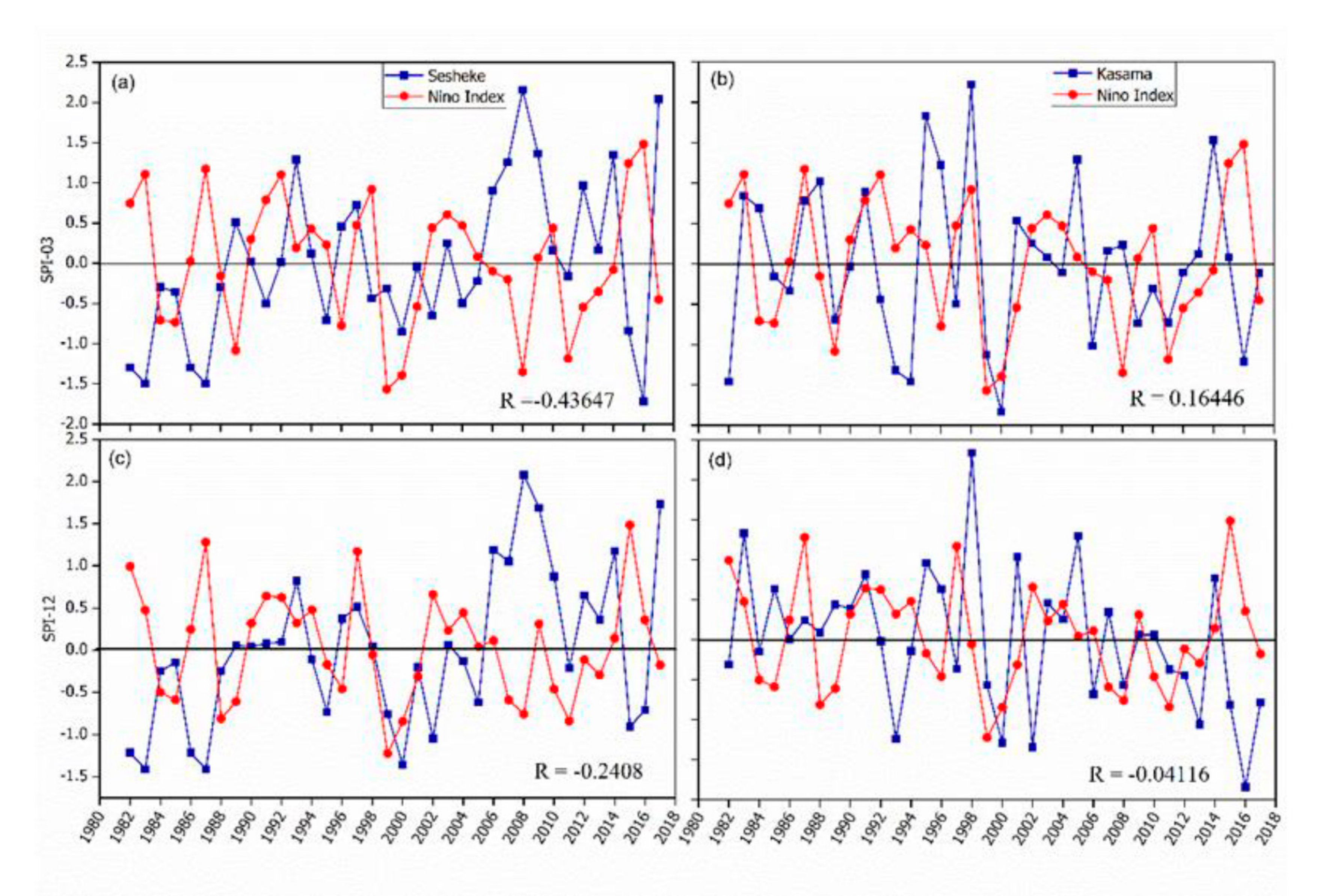
| Description | SPI Magnitude |
|---|---|
| Extreme Drought | ≤−2 |
| Severe Drought | −1.9 to −1.5 |
| Moderate Drought | −1.4 to −1.0 |
| Near Normal Conditions | −0.9 to 0.9 |
Publisher’s Note: MDPI stays neutral with regard to jurisdictional claims in published maps and institutional affiliations. |
© 2020 by the authors. Licensee MDPI, Basel, Switzerland. This article is an open access article distributed under the terms and conditions of the Creative Commons Attribution (CC BY) license (http://creativecommons.org/licenses/by/4.0/).
Share and Cite
Musonda, B.; Jing, Y.; Iyakaremye, V.; Ojara, M. Analysis of Long-Term Variations of Drought Characteristics Using Standardized Precipitation Index over Zambia. Atmosphere 2020, 11, 1268. https://doi.org/10.3390/atmos11121268
Musonda B, Jing Y, Iyakaremye V, Ojara M. Analysis of Long-Term Variations of Drought Characteristics Using Standardized Precipitation Index over Zambia. Atmosphere. 2020; 11(12):1268. https://doi.org/10.3390/atmos11121268
Chicago/Turabian StyleMusonda, Bathsheba, Yuanshu Jing, Vedaste Iyakaremye, and Moses Ojara. 2020. "Analysis of Long-Term Variations of Drought Characteristics Using Standardized Precipitation Index over Zambia" Atmosphere 11, no. 12: 1268. https://doi.org/10.3390/atmos11121268
APA StyleMusonda, B., Jing, Y., Iyakaremye, V., & Ojara, M. (2020). Analysis of Long-Term Variations of Drought Characteristics Using Standardized Precipitation Index over Zambia. Atmosphere, 11(12), 1268. https://doi.org/10.3390/atmos11121268





